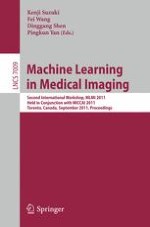2011 | Buch
Machine Learning in Medical Imaging
Second International Workshop, MLMI 2011, Held in Conjunction with MICCAI 2011, Toronto, Canada, September 18, 2011. Proceedings
herausgegeben von: Kenji Suzuki, Fei Wang, Dinggang Shen, Pingkun Yan
Verlag: Springer Berlin Heidelberg
Buchreihe : Lecture Notes in Computer Science
